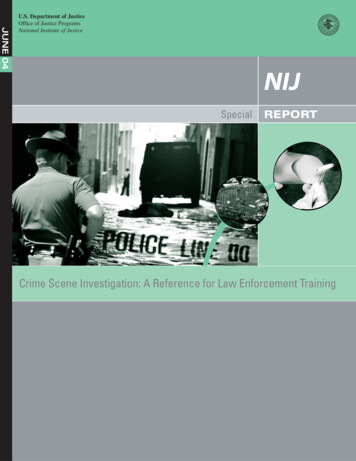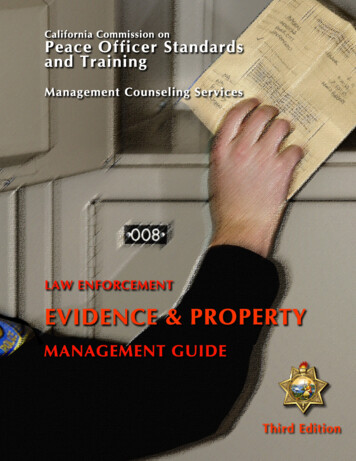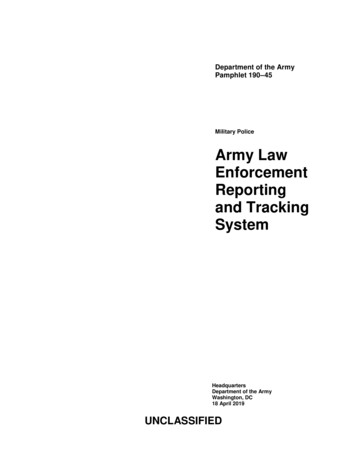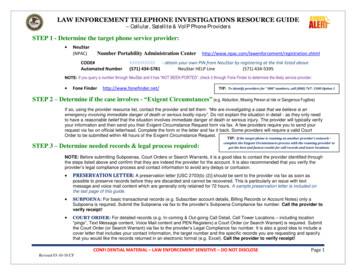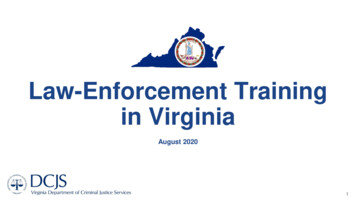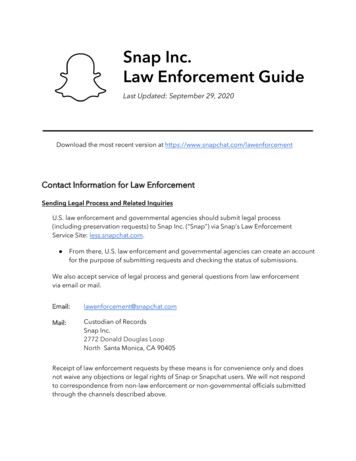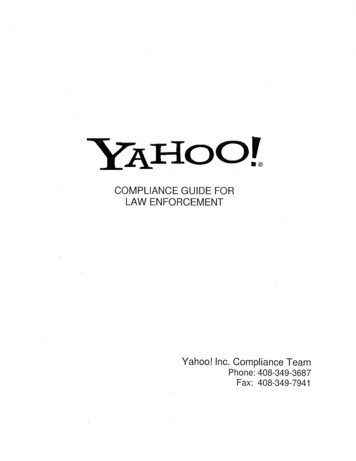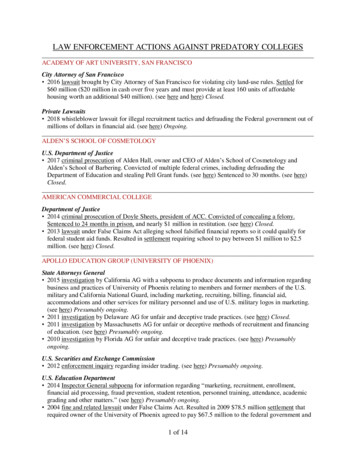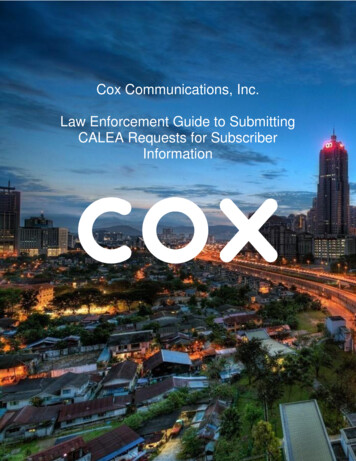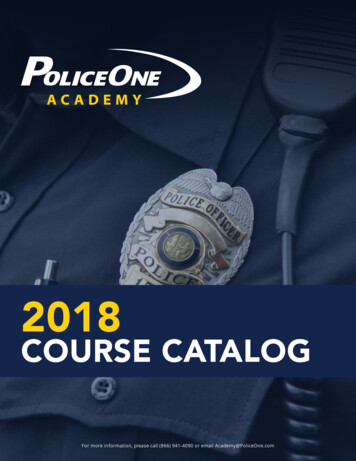
Transcription
2018COURSE CATALOG1For more information, please call (866) 941-4090 or email Academy@PoliceOne.comFor more information, please call (866) 941-4090 or email Academy@PoliceOne.com
TABLE OF CONTENTSActive Shooter. 3Leadership.19 – 20Campus Policing. 4Legal.20 – 22Communication Skills. 4 – 5Lt. Col. Grossman. 22Corrections. 5Motivational. 22Crowd Control. 5 – 6Miscellaneous Law Enforcement Training.22 – 23Cultural Awareness. 6 – 7Narcotics Enforcement. 23Defensive Tactics. 7 – 10Off-Duty Safety & Survival. 23Dispatch Communications.10 – 11Officer Survival.23 – 25Edged Weapons. 11OSHA/FEMA. 25Emotional and Psychological Disorders.11 – 12Patrol.25 – 26Environmental Crimes.12 – 13Pursuit.26 – 27Equipment Training. 13Real-Life/Reality Video Training. 27Female Officers. 13Report Writing. 27Firearms.13 – 14Responding To Emergencies.27 – 28Fitness & Nutrition.14 – 15Subject Control.28 – 29Gangs. 15Tactical First Aid. 29Informational.15 – 16Tactical Operations. 29Internet and Technology in Law Enforcement.16 – 17Terrorism.29 – 30Investigative Skills.17 – 18The Will to Win. 30K-9 Behaviors.18 – 19Traffic Stops & Safety.30 - 31K-9 Operations. 19For more information, please call (866) 941-4090 or email Academy@PoliceOne.com2
VIDEO BLOCKSACTIVE SHOOTERActive Shooter FULL-LENGTH COURSESActive Shooter: Phases and Prevention1 HOURBy recognizing the signs exhibited in the past by perpetrators ofactive shooter incidents, you will be better prepared to preventtragedy and loss of life before an attack is made. This coursecovers common motives and patterns of behavior.Videos in this course include:Responding to active shooter calls can be one of the mostdangerous situations officers will encounter. Training videosincluded here discuss protocol for response, the five phases of anactive shooter, active vs classic barricade suspect, and more.Active Shooter 11 HOURVideos in this course include: Shooting Tactics for Multiple Officers in Close Quarters Active Shooter vs Barricade Situations Reality Training: Sparrow Firearms Training The Five Phases of an Active ShooterActive Shooter: Recognition and Basic Response1 HOURThe hotel attacks in Mumbai illustrate a scenario with multiplesimultaneous shooters. When planning your response, everyincident must be treated with the “Rule of Plus One,” meaning ifyou’ve found and neutralized one shooter you must search foradditional shooters until the location has been secured.Videos in this course include: Active Shooter Update Equipment to Carry on an Active Shooter Response Multiple Active Shooters Responsibilities of the First Officer in an Active ShooterIncidentActive Shooter 21 HOURVideos in this course include: Active Shooter Response Response Strategy for Multiple-Location Attacks Active Shooters in our Schools Spear System: Sudden AmbushAmbush Awareness and Preparation Active Shooter Training1 HOURThis course will educate officers on the threat of ambushes andcreate awareness of this important issue. It provides an in-depthoverview of the topic and offers a comprehensive case study andanalysis of Lakewood, Washington incident where four officers losttheir lives. In addition, this course outlines a firearms training drillthat officers can use right now to prepare for possible attacks. A Formidable Foe for Law EnforcementActive Shooter 31 HOURVideos in this course include: Dealing with an AmbushVideos in this course include: Concealed Carry in our Nation’s Schools Preparing for an Ambush The Sheep, the Wolf and the Sheepdog The Legacy of the Lakewood Four The Truth about Violence 360 Firearm Drills Violent Visual Imagery and Children Restaurant Safety for Police Officers Virginia Tech Massacre Preparing for an Active ShooterLaw Enforcement Response to ActiveShooter IncidentActive Shooter 42 HOURSIn this two-hour course, you will learn the proper responses to anactive shooter incident; gain an understanding of past incidents;and study future incident prevention.Videos in this course include:1 HOURVideos in this course include: Campus Police Agencies And Their Collaborative (Matt Stiehm) Challenges Of Implementing Active Shooter Response Training Surviving An Active Shooter - La County Sheriff Rapid Deployment 2.0 New Training Protocols Being Practiced In Boulder For ‘ActiveShooter’ Situations Training Teachers To Respond To Active Shooter Incidents How Police Respond In ‘Active Shooter’ Situations Regional Police Holding Active Shooter Training At CheneyMiddle School Campus Police Train For “Active Shooter Response” Church Active Shooter Training Downrange EMS: Critical Care When The Scene Isn’t Safe ADDITIONAL VIDEOS Multi-Jurisdictional Response to Mass Casualty Incidents onCollege Campuses Reality Training: A Deadly Parking Lot Shooting Active Shooter: It’s Not A Question Of If I-Team: Behind The Scenes Active Shooter Training San Antonio Police Department: Civilian Response To ActiveShooter3For more information, please call (866) 941-4090 or email Academy@PoliceOne.com
CAMPUS POLICINGCOMMUNICATION SKILLS FULL-LENGTH COURSE(S) FULL-LENGTH COURSE(S)Bomb Threats in SchoolsCrisis Intervention Training Overview1 HOUR1 HOURThis one-hour course will instruct law enforcement to effectivelyprevent and handle bomb threat situations.The Crisis Intervention Team (CIT) Overview is an innovativefirst-responder model of police-based crisis intervention with thecommunity, health care, and advocacy partnerships. This one-hourcourse is designed to connect law enforcement, mental healthservices, and the public.Videos in this course include: School Bomb ThreatsCampus Based Training: Clery Act2 HOURSThis training is intended to familiarize you with the requirementsof the Jeanne Clery Campus Security Policy and Crime StatisticsDisclosure Act, most commonly referred to as the Clery Act. Alongwith a general overview of the Clery Act, this course will providean understanding of universities’ obligations under the law, thereporting requirements for Campus Security Authorities, andthe proper procedures for reporting allegations of crime. Thistwo-hour course will equip you with knowledge on the Clery Actand how to follow the guidelines to create a safe environment foreveryone in the community.Videos in this course include: Clery Act Training Introduction Reportable Locations Video University Covers Up a Rape & Murder PSU still awaiting word on federal investigation regardingClery Act Virginia Tech Found in Violation of Clery Act VIDEO BLOCKSCommunication SkillsWhether on the street or in the courtroom, having the skill torecognize non-verbal cues, conduct thorough field interviews, orbuild rapport with criminal informants is a core competency forlaw enforcement professionals. This section covers everythingfrom analyzing a suspect’s body language to managing callsinvolving persons with autism.Communication Skills 11 HOURVideos in this course include: New Era, New Rules The Art of Asking Questions Verbal Abuse Deflectors Responding to Persons with Autism Tactical Communication Applied to E-mail Strengthening Relations with Local Media Rape Cover-Up 101Communication Skills 2 Clery Act Training Close1 HOURPreventing and Addressing Bullying in SchoolsVideos in this course include:1 HOUR Priorities of LifeThis one hour course will inform and share proven ways localSROs and other law enforcement officials can address andrespond to bullying. Although they are not on-site to carry outdisciplinary functions that fall under the purview of schoolpersonnel, SROs can play an important role as law enforcers,educators, and informal counselors. I Got Your Back ConceptVideos in this course include: Who Will Stop The Bullying? Bully Awareness Prevention Officer-Dispatcher Relations Cultural Awareness for Law Enforcement Everyday Heroes and the Media Getting Back to BasicsCommunication Skills 31 HOURVideos in this course include: VIDEO BLOCKS Autism Recognition and ResponseCampus Policing Body Language: Detecting Deceit1 HOUR Body Language: Psychological vs PhysiologicalThis one-hour training block will address the unique issues thatarise for law enforcement on college campuses. Body Language: Questioning a SubjectVideos in this course include: Preparing for an Effective Emergency Response on CollegeCampuses The Complexities of Patrolling College Campuses Multi-Jurisdictional Response to Mass Casualty Incidents onCollege Campuses Sex Crime Investigations on College Campuses Combining Verbal and Physical ControlCommunication Skills 41 HOURVideos in this course include: Fire, EMS & LE Interface Arresting Communication Providing Closure for the Dispatcher Improving Media Relations Emergency Radio TrafficFor more information, please call (866) 941-4090 or email Academy@PoliceOne.com4
The Importance of Communication in LawEnforcementCorrections 31 HOURVideos in this course include:Communication is key. It plays a big part in every policingsituation, and effective communication skills are essentialto mitigate the loss of life. In this one-hour training blockcourse, the learner will understand the importance of effectivecommunication in deescalating tactics, community relations, andin peer interactions. Why Communication is Key in Police Pursuits The Use of De-Escalation Tactics When Responding to aCrisis Call1 HOUR Active Countermeasures: Relative Positioning Drills Active Countermeasures: Touch Drills Baton Carries Baton Strikes in Confined Spaces Baton Training in the Classroom Baton Use in Close Quarters Conducting Searches in a Corrections Setting Tactical Communications: On the Street How to Use Striking Shields Reality Training: The Irrational Subject and our Use of Language Outfitting for Corrections Reality Training: Mitigating the Aftermath of a Critical IncidentCorrections 41 HOUR ADDITIONAL VIDEOSVideos in this course include: Dealing with Military Veterans Establishing a Relationship Between your Department andLocal Media The Use of De-Escalation Tactics When Responding to a CrisisCall Large Squad Riot Techniques Winning Courtroom Confrontations Reality Training: Courthouse Shooting Training with Inert OC Spray: Hitting Your Target Ground Stabilization after batonCORRECTIONS Close-Quarter Striking TechniquesCorrections courses are available with optional Correctionsbundle only. VIDEO BLOCKS Ground Positions: Weapon Retention Edged Weapons Defense Training ADDITIONAL VIDEOSCorrectionsCorrections courses cover a wide variety of training, including:tactical team formations; Disturbance Control Teams; cuffingtechniques; safe cell extraction; and excited delirium. Courtroom Searches Proper Response Reality Training: Field Sobriety Test Searching a SuspectCorrections 1 Sudden Attack in a Booking Area1 HOUR Tactical FormationsVideos in this course include: Toolbox Approach Reality Training: Control Tactics in Court Direct Supervision of InmatesCROWD CONTROL Responding to an Incident in a Courtroom Securing an Inmate from Knee on the Belly VIDEO BLOCKS Shield Selection for Cell ExtractionsCrowd Control Standing Pat DownCrowd control is a more and more common concern for agenciesof all sizes. In these videos, you will learn how to prepare, bothas an agency and as an individual, to respond effectively to thesetypes of incidents and the various challenges they pose Surviving a Jail Stabbing AssaultCorrections 21 HOURCrowd Control 1Videos in this course include: Applying a Simple Foot Trap in a Correctional Setting1 HOURVideos in this course include: Baton Close Quarter Strikes Movement Formation vs. Fighting Formation Cell Extraction Techniques Reality Training: Crowd Control, Cameras Rolling Police vs Correctional Hostage Negotiations Crowd Control: Bicycles Social Contracts Crowd Control: SUV Running Boards Star Tactic Variations Crowd Control: The Sleeping Dragon Crowd Control: Writing an Ops Plan5For more information, please call (866) 941-4090 or email Academy@PoliceOne.com
CROWD CONTROL (CONT.)Videos in this course include:Crowd Control 2 CPD renewing focus toward community policing1 HOUR Richmond, California: Community policing done rightVideos in this course include: This is What Community Oriented Policing Looks Like Basic Team Formations Blast Ball: For Less Lethal Crowd Control Crowd Control: An Overview Crowd Control: Cuffing with Multiple Flex Ties Crowd Control: Handcuffing Crowd Control: Team SelectionCrowd Control 31 HOURVideos in this course include:Community Policing Strategies1 HOURThis one-hour course provides a brief description of theapproaches that have been successfully developed andimplemented at the local level to reduce crime and disorder.Examples used in this course are a compilation of the bestpractices of the more than 50 winners and 150 finalists of theCommunity Policing Award. Many of the innovative strategicprinciples discussed in this course can be adopted by other lawenforcement agencies across the U.S.Videos in this course include: Crowd Control: Continuum LAPD seeks to build trust through community policing Crowd Control: Demonstrator Tactics Community policing is often overlooked Crowd Control: Equipment Community Policing Aims To Create Safer Neighborhoods Crowd Control: Intelligence Hillsboro Police Department - Community Policing Crowd Control: Less-Lethal Crowd Control Equipment Meet the Metro Transit Police Department’s NorthsideCommunity Policing TeamCrowd Control 41 HOURVideos in this course include: Reality Training: Responding To Edged Weapon Attacks Defending a Forehand Slash with Edged Weapons Edged Weapon Defense Empty Hand against a Knife Attack Forehand Slash in Knife Attack Knife Defense Side Control with Edged Weapon Knife Defense with Tony GregoryCULTURAL AWARENESS FULL-LENGTH COURSESAnti-Bias Training For Law Enforcement1 HOURCertain geographic areas are statistically more acceptingof different races and cultures than others. In the past, lawenforcement in some areas of the country had a reputation ofhaving a racial bias. While much about society is different, bothparties — citizens and law enforcement — can still have thoughtsthat reflect historical perspective. This course will equip officers toaddress racial problems and ensure the community understandstheir professionalism.Videos in this course include: How deeply rooted biases affect how police enforce the law NYPD’s Stop-and-Frisk: Racial Profiling or ‘Proactive Policing’?Community Policing2 HOURSPolice chiefs have an interest in offering the highest-quality policeservice possible. Community policing means quality police service.Agencies that are committed to community policing will developpartnerships with their community. This course will equip you withknowledge about community policing and the challenges this typeof policing faces. Lakewood Community PolicingCultural Diversity for Law Enforcement1 HOURWith the demographic makeup of the United States changingdramatically over the last 25 years, law enforcement, now morethan ever, must possess the cultural competency to encouragepositive communication and enhance productivity in theworkplace. By taking this course, the learner will examine thefactors that make up our individual cultures and the ways bywhich culture and law enforcement can merge.Implicit Bias1 HOURThis one-hour course will discuss implicit bias regarding itsdefinition, common ways that it may be revealed, as well as thedifferent forms it may come in. Additionally, this Implicit Biascourse instructs the user on how to identify and overcome anactual implicit bias.LGBTI Issues1 HOURConcerns about the treatment of Lesbian Gay BisexualTransgender Intersex (LGBTI) individuals come amid a nationaltopic of police-community relations, which largely focused on copsand communities of color. This one-hour course is designed toenhance your ability to identify the importance of proper trainingand knowledge on the LGBTI community.Videos in this course include: LGBTI Hate Crimes And The Police Terms For Police To Avoid With LGBT Persons Brian Sharp Discusses Gender Identity And Gender Expression Creating Awareness And Understanding Of The TransgenderCommunity News - LGBT Police Training - The Dove ‘It Gets Better’, LGBT Officers Inspiring MessageFor more information, please call (866) 941-4090 or email Academy@PoliceOne.com6
Procedural JusticeCultural Awareness 12 HOURS1 HOURNow more than ever, Police Chiefs must be able to recognize andrespond to quickly changing issues and opportunities. Many areapplying the concepts of “legitimacy” and “procedural justice” asthey pertain to policing. In this 2-hour course, you will discover themany challenges policing faces every day and the means by whichpolice can improve their image with the public.Videos in this course include:Videos in this course include: Cultural Diversity – Knowing Your Community Cultural Diversity: Challenging Stereotypes Cultural Diversity: Cognitive Styles Cultural Diversity: Communication contextCultural Awareness 2 Implementing “Procedural Justice” nationwide Minneapolis Selected for DOJ Initiative to Rebuild Trust of Police Stockton Police Selected for DOJ ‘Community
For more information please call (866) 941-4090 or email AcademyPoliceOne.com 4 CAMPUS POLICING FULL-LENGTH COURSE(S) Bomb Threats in Schools 1 HOUR This one

